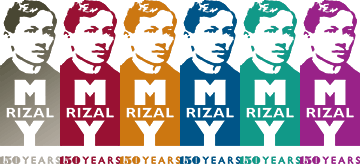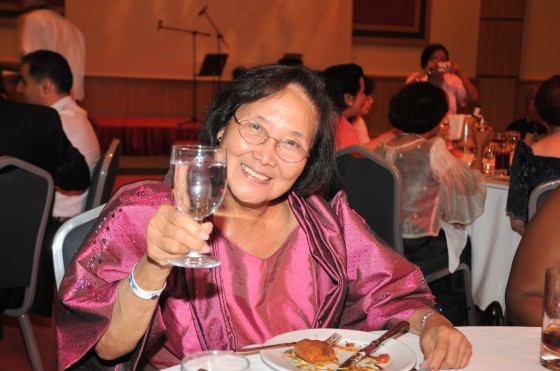Maximo Viola grand niece, writer and educator Dr. Penelope Flores talks about her upcoming book, “Tracing Rizal’s Travel Extravaganza.” Click on the photo to learn more about this fascinating book, and who Maximo Viola is.
She is also a passionate blogger about Rizal. Her latest blog enumerates Rizal’s many loves, shows their pics, and shares her opinions on whether Rizal was serious with them, or just having a crush. Here’s the link.
Cheers to Rizal, to Maximo Viola, and to you, from Dr. Penelope Flores!
INTERVIEW WITH DR. PENELOPE FLORES, AUTHOR OF TRACING RIZAL’S TRAVEL EXTRAVAGANZA
MyRizal: Can you tell us your family relationship with Máximo Viola, José Rizal’s friend who helped publish the Noli me Tangere?
Penélope: I’m glad you asked. Máximo Viola had several sisters. One of them was Juliana Viola who was my father’s mother or my grandmother.
MyRizal: So, that makes you a grand niece of Maximo Viola!
Penélope: Right, and by the way, Maite, your very own father, Manuel O. Gallego was a grand nephew of Máximo Viola through Inocencia, another Viola sister. The offspring of Máximo, Inocencia and Juliana are first cousins.
MyRizal: What’s your academic background?
Penélope: I have a Ph.D. in Comparative Education from the University of Chicago, and a Master’s of Education degree from the University of Pennsylvania. I earned my graduate education at the University of the Philippine’s College of Education in Diliman, QC. I also have a Bachelor of Science degree in education (Mathematics) from the Philippine Normal University. That makes me an educator (one who is a practising teacher/professional) and an educationist (one who examines different societies by comparing their education systems and its outcomes).
MyRizal: Then, could you tell us something about your teaching career?
Penélope: Certainly. For 25 years I taught education courses or teacher credentialing seminars at San Francisco State University. In California, every K-12 teacher must earn a California Teaching Certificate (one year after earning a Bachelor’s degree) before they can be appointed to any teaching position. Earlier, eight years before, I was the Research Evaluation Director for the University of Chicago’s School Mathematics Project.
MyRizal: Besides teaching in the US, did you ever teach in the Philippines?
Penélope: Yes, of course, I was an assistant professor of education at the College of Education, University of the Philippines, Diliman. Previous to that, I began as an elementary school teacher at the UP Elementary School, university campus. My last appointment at UP Elementary School was as the Vice Principal.
MyRizal: In your teaching career, you must have had intensive interaction with young people for many years. Do you notice any difference in attitude between the youth you first started teaching and the youth in recent years?
Penélope: What a great question! Yes, when I first started teaching, the students were very good in memorizing details and good at reciting them back to the teacher. There were few basic textbooks and supplementary books were a luxury when I was a beginning teacher. Now, I see a plethora of books. What is exemplary is that these are written by Philippine-based authors. The difference between the students of my time and today’s students is in the order of their maturity levels. Today’s students are more exposed to global education. They have become “critical thinkers.” They have progressed from regurgitating historical materials about Rizal to researching and “googling” Rizal primary sources and materials and of visiting such important websites such as this.
MyRizal: What are your past and current pursuits related to Dr. José Rizal?
Penélope: I now pursue Tracing Rizal’s Travel Extravaganza. I was inspired by the publication of Paz Policarpio Mendez’s book that researched the places where Rizal lived in Spain, Paris and Germany. Then through the help of her husband (Ambassador Mauro Mendez) she placed historical markers on each Rizal-related edifice. In 2001, armed with Rizal Historical Marker as a travel guide, I traced José Rizal’s travels. I simply got hooked! I spent every summer and every year in Spain and Europe. Then I realized that at some point in Rizal’s travels in Europe, (1886-1887) there was another person travelling with him for six months. It was Máximo Viola! Whoa!!! I noted this piece of information can only be found in Endnotes and obscurely buried in Footnotes. What a great chance to recreate this European travel mode of two young Filipino medicos: ages 25 (Rizal) and 26 (Viola), and bring it to light.
MyRizal: We understand you are writing a book right now about this friendship of José Rizal and Máximo Viola? Please tell us more about this.
Penélope: Yes, I ‘m writing a portrait of Rizal through the eyes of his traveling companion, Máximo Viola. I read and reread Máximo Viola’s memoirs about his travels with José Rizal. However, he wrote his memoirs when his memory was not as clear (it was published in 1913), 26 years after the fact. In addition, in Viola’s memoirs, he kept bemoaning the fact that his travel notes were lost during the Revolution of 1889 and the Philippine-American war of 1900. So, I studied all of Rizal’s correspondences to Blumentritt, to his family, and his friends, and noted all the places where he said something about Viola, his traveling “countryman.”
I noted that Viola, instead of writing the sights in their travels, would very cavalierly write it off in his memoirs saying “we followed the Baedeker Travel Guidebook’s significant places to visit.” That was all. Therefore, to recreate those sceneries, I had to request San Francisco Public Library to procure for me an 1886 Karl Baedeker Travel Guidebook of Germany and Switzerland.
MyRizal: What is the central thesis, and when do you expect it to be finished and published?
Penélope: My main goal is to portray a young Rizal, the graduate; through the eyes of his equal–the young Viola, the graduate. The central thesis is to let Rizalista scholars and students know about this event that had been largely ignored in our history books. I pick up Viola’s memoirs of his travels with José Rizal, and then I make a historical dramatization of this friendship with almost every paragraph citing a Rizal correspondence or journal entry. Scholars call this proper citation. I call this “braided narrative.” Then, I put in my own personal experience in tracing the footsteps of these two gentlemen almost 150 years later. The sites and sceneries have changed where I dutifully compare what Rizal and Viola saw in 1886, and what they look today circa 2013. I expect to have a book launching sometime in 2014 and I’ll invite you and the rest of the Rizal clan and the Viola clan for a grand get-together to commemorate the Rizal–Viola special friendship. Please put this date in your calendar.
MyRizal: If José Rizal were alive today, what do you think would be his main message to the young people, particularly to overseas 2nd and 3rd generation Filipinos?
Penélope: If Rizal were alive today, his message to our young people would be: “Get an education and pursue high achievement goals.”
MyRizal: Many thanks for sharing your thoughts and insights. We look forward to your book launching!

